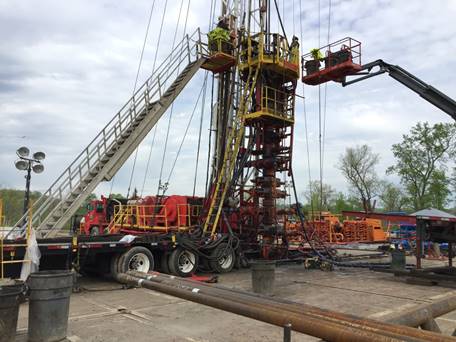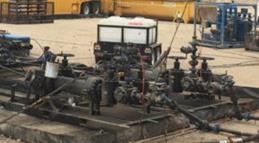
Figure 1. Work over rig (WOR) with snubbing package drilling out plugs.
PLUG DRILL-OUT
Once the well has been completely fraced and the equipment has moved off of location, it's time to begin to bring the well into the production phase. However, if composite plugs were used to isolate frac stages, then they will physically need to be drilled out. This will require a coiled tubing unit, "snubbing unit," or an equivalent.

Figure 1. Work over rig (WOR) with snubbing package drilling out plugs.
The process of plug drill out is very similar to drilling in the sense that a bit is sent down on the end of the pipe which will literally drill through the plug. Mud is circulated like drilling as well. Pieces of the plugs will accompany the mud returns to the surface. Thus, a "plug catcher" is used in the flow line which removes the large chunks from the plugs.
Once the plug above the last fraced zone has been removed, the energized formation will want to begin producing. This is why a snubbing unit, coiled tubing unit, or an equivalent must be used. The well at the surface will quickly become pressurized once the isolation plugs are drilled out. These units must have the ability to push the bit further into the well against pressure from the formation.

Figure 2. Plug catcher.
However, keep in mind that if the company did not use composite plugs in their well to isolate frac stages, this process might be eliminated. An example would be if dissolvable plugs were used. Dissolvable plugs will dissolve after a certain amount of time given a particular temperature range. This is an amazing technology that is still being adapted and refined, but use in some formations doesn't look as promising yet due to lower temperatures. Also, use of dissolvable plugs is somewhat risky for the operator, because if one doesn't dissolve, the lateral from that plug on will not be capable of production (as it is being blocked). In such a scenario, it would have to be drilled out anyways. In other words, all it takes is one failure and the company will have to bring a snubbing unit in any way. Also, with dissolvables, if they don't dissolve very well or fully, they can leave unnecessary junk in the well which could lead to worse production and other complications later on.
EXTRA: Oilfield Basics Video Blog(s)